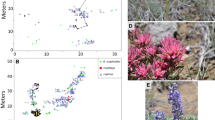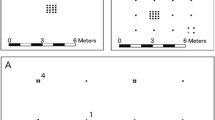Summary
The dispersion pattern of resources can have a significant effect on foraging behavior. We examined the dispersion pattern of standing crop of nectar in a population of Delphinium nelsonii. The nectar content of flowers was measured for subject inflorescences and their two nearest neighbors. Inflorescences were divided into those which had some nectar (hot plants) and those which had none (cold plants). Tests for independence showed that subject plants and their neighbors were likely to have the same “temperature”, indicating that resources were patchy. The implications of this pattern for the foraging movements of bumblebees are discussed.
Similar content being viewed by others
References
Beukema, J.J.: Predation by the three spined stickleback (Gasterosteus aculeatus). Behaviour 31, 1–126 (1968)
Chandler, A.E.F.: Locomotory behavior of first instar larvae of aphidophagous Syrphidae (Diptera) after contact with aphids. Anim. Behav. 17, 673–678 (1969)
Charnov, E.L.: Optimal foraging: The marginal value theorem. Theor. Pop. Biol. 9, 129–136 (1976)
Cody, M.L.: Finch flocks in the Mohave Desert. Theor. Pop. Biol. 2, 142–158 (1971)
Cody, M.L.: Optimization in ecology. Science 183, 1156–1164 (1974)
Gibb, J.: Predation by tits and squirrels on the eucosmid Enarmonia conicolama (Heyl.). J. Anim. Ecol. 27, 375–396 (1958)
Kleerekoper, H., Timms, A.M., Westlake, G.F., Davy, F.B., Malar, T., Anderson, V.M.: An analysis of locomotor behaviour of goldfish (Carassius auratus). Anim. Behav. 18, 317–330 (1970)
Krebs, J.R., Ryan, J.C., Charnov, E.L.: Hunting by expectation or optimal foraging? A study of patch use by chickadees. Anim. Behav. 22, 953–964 (1974)
Krebs, J.R., Kacelnik, A., Taylor, P.: Test of optimal sampling by foraging great tits. Nature 275, 27–31 (1978)
Laing, J.: Host finding of insect parasites. I. Observations on the finding of hosts by Alysia manducator, Mormoniella vitripennis and Trichogramma evanescens. J. Anim. Ecol. 6, 298–317 (1937)
Laing, J.: Host finding by insect parasites. II. The chance of Trichogramma evanescens finding its hosts. J. Exp. Biol. 15, 281–302 (1938)
Levin, D.A., Kerster, N.W.: Density-dependent gene dispersal in Liatris. Amer. Natur 103, 61–74 (1969a)
Levin, D.A., Kerster, N.W.: The dependence of bee-mediated pollen and gene dispersal upon plant density. Evolution 23, 560–571 (1969b)
Levin, D.A., Kerster, N.W., Niedzlek, M.: Pollinator flight directionality and its effect on pollen flow. Evolution 25, 113–118 (1971)
MacArthur, R.H., Pianka, E.: On optimal use of a patchy environment. Amer. Natur. 100, 603–608 (1966)
Mitchell, B.: Ecology of two carabid beetles, Bembidion lampros (Herbst) and Trechus quadristriatus (Schrank). I. Life cycles and feeding behavior. J. Anim. Ecol. 32, 289–299 (1963)
Price, M.V., Waser, N.M.: Pollen dispersal and optimal outcrossing in Delphinium nelsonii, A montane wildflower. Nature 277, 294–297 (1979)
Pyke, G.H.: Optimal foraging: Movement patterns of bumblebees between inflorescences. Theor. Pop. Biol. 13, 72–98 (1978)
Reichman, O.J., Oberstein, D.: Selection of seed distribution types by Dipodomys merriami and Perognathus amplus. Ecology 58, 636–643 (1977)
Richerson, J.V., Borden, J.H.: Host finding behavior of Coeloides brunneri (Hymenoptera: Braconidae). Can. Entomol. 104, 1235–1250 (1972)
Schoener, T.W.: Theory of feeding strategies. Ann. Rev. Ecol. Syst. 2, 369–404 (1971)
Smith, J.N.M.: The food searching behavior of two European thrushes: I. Description and analysis of search path. Behaviour 48, 276–302 (1974a)
Smith, J.N.M.: The food searching behavior of two European thrushes: II. The adaptiveness of the search patterns. Behaviour 49, 1–61 (1974b)
Tinbergen, N., Impekoven, M., Franck, D.: An experiment on spacing-out as a defense against predation. Behaviour 28, 307–320 (1967)
Tullock, G.: The coal tit as a careful shopper. Amer. Natur. 105, 77–80 (1971)
Weins, J.A.: Population responses to patchy environments. Ann. Rev. Ecol. Syst. 7, 81–120 (1976)
Zimmerman, M.: Optimal foraging: A case for random movements. Oecologia (Berl.), in press (1979)
Author information
Authors and Affiliations
Additional information
The order of authorship was determined by the flip of a coin
Rights and permissions
About this article
Cite this article
Pleasants, J.M., Zimmerman, M. Patchiness in the dispersion of nectar resources: Evidence for hot and cold spots. Oecologia 41, 283–288 (1979). https://doi.org/10.1007/BF00377432
Received:
Issue Date:
DOI: https://doi.org/10.1007/BF00377432




